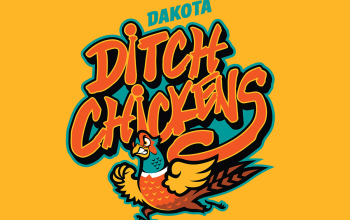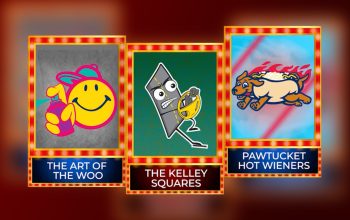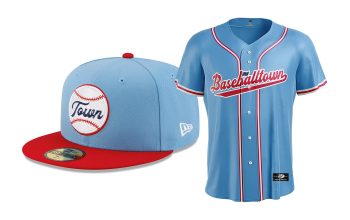
When the New York Mets announced that they would rename their newly acquired Triple-A franchise in Syracuse the Mets last season, I was hoping that it would feature a modified version of its iconic skyline logo. A look that was quite popular with many of its affiliates during the 1980s, but dated back to the late 1960s.
The Syracuse Mets logo does feature the team’s script but is nowhere close to the looks the club once featured in the cities of Lynchburg, Va.; Little Falls, N.Y.; Columbia, S.C.; and Wausau, Wisc. Did the Mets miss their mark on returning a look that was a perfect balance between themselves and its minor league market?
The Mets tweaked their iconic skyline logo for many of its minor league franchises. The modified look served the purpose of showing its allegiance to the parent club and would also tailor its image for a particular farm club. These logos would use many elements of the region that would include the city skyline, landscape, and vegetation.
New York might have first tinkered with its emblem for the Winter Haven Mets of the Florida State League in 1967. A silhouette of its home field, Chain O’Lakes Stadium replaced the New York skyline in the logo. There were also three oranges on the bottom, and the interlocking “WH” would stand in place of the “NY”.
In 1968, the Mets placed a Double-A squad in the Texas League and properly named it the Memphis Blues. The parent club heavily influenced this beauty of a design that featured the Memphis skyline and a musical eighth note that formed the letter“B” in the word Blues. An extra eighth note ran through the roundel image that included the city’s name in the flag of the tail. The Mets would end its affiliation in Memphis after 1973.

In 1975, the Wausau Mets of the Midwest League brought baseball back to town for the first time since 1957. The team replaced the New York City skyline with the nearby Rib Mountain and a couple of pine trees colored in orange. The only thing similar was the stitches of the baseball in the logo.
The following season the Grays Harbor Mets were formed and resurrected the same logo from the previous season in Wasau. The team played at Olympic Stadium in Hoquiam, Washington, and located near the Olympic National Forest. The use of trees in the logo would fit the new team well with its surroundings but would leave after just one season in the Pacific Northwest.

The Little Falls Mets would debut in 1979 as a short-season Class A farm club in the NY-Penn League. Little Falls has a population of 6,000 residents and hosted the Mets until 1988 when it relocated to Pittsfield, Massachusetts. Team owner Michael Casey reported that he had lost $35,000 during its last season.
The Pittsfield Mets would also transfer the modified logo, featuring a mountain in place of a skyline and trail or river underneath the Mets script to the Wahconah Park. The replacement of the letters of “LF” with the letter “P” was the only change. Pittsfield would use this logo until 1994 until introducing an updated logo. The Mets would operate the Berkshires until 2000 and eventually relocate to Brooklyn in 2001.
The Lynchburg Mets were a Carolina League Class-A farm club that operated in town from 1976 to 1987. Many of the natural landscape that surrounds the “Hill City” would be incorporated into its logo. The city is near the foothills of the Blue Ridge Mountains.
What is probably most surprising is that Lynchburg used the parent club’s logo on uniforms, schedules, programs, and signage during the majority of its years in town. The club would introduce its own version of the logo sometime in the mid-1980s, perhaps even as late as 1986.
The Lynchburg Mets logo was a thing of beauty and incorporated many aspects of the city’s surroundings from its skyline, local landmarks, and the Blue Ridge Mountains. The buildings appeared to include Court Street Baptist Church, Allied Arts building, and The Aviary.
In 1987, the last for the club in town, an updated version of the logo appeared on the cover of its annual program. The silhouette of the mountains and buildings were stripped away to create a simpler and a little cleaner look. It would be the final year for the Mets in Lynchburg as they would relocate to Port St Lucie to a new facility that would also serve a home for spring training.
In 1983 the Columbia Mets began its first year in the capital of South Carolina and had its very own modified logo. C-Mets former Vice-President/General Manager Bill Blackwell believes the design was created in New York in conjunction with the club’s head of minor league operations. However, he did not assist or have any input on its design.
In 1990 the C-Mets changed the emblem to include the state capital and the city name written in the Mets font as “a new look of the 90’s”. They would change their name to the Capital City Bombers in 1992.

The Kingsport Mets had its own version of the team’s logo that was not as creative as the ones mentioned in this article. It appears that sometime around 1992 the club swapped the “NY” with a “K” in the logo and placed the city’s name arched over the logo. Other than those two minor changes, the logo featured the New York City skyline.
In 2009, the Mets changed its affiliation from New Orleans to Buffalo and created a logo that featured many elements of the skyline logo but to it up several levels. It was a bold design that one could easily distinguish it as a Mets affiliate. The new design featured a charging bison in front of a Buffalo skyline with the colors of blue and orange.
Mike Buczkowski, Vice-President/General Manager of the Bisons, said that it was a design with an old-fashion feel and a modern look with a twist. The symbol and colors would be used until the Bisons partnered with the Toronto Blue Jays in 2013 and the Mets headed west to Las Vegas.

There are no minor league affiliates within the organization that uses a modified version of the skyline logo. The St. Lucie Mets do have their own version of Mr. Met dressed for a day at the beach with sunglasses, a swimsuit, and sandals.
In an era of minor league baseball nicknames and logos that sharply differ from the parent club’s identity, we might have seen the end of the regionalized Mets skyline logo. However, I am hoping for the Syracuse Mets to introduce a logo with its skyline one day in the near future.










